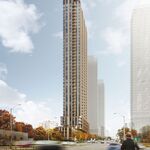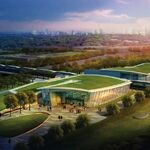scarberiankhatru
Senior Member
Again, I don't know their exact methodology, but when they calculate forecasted ridership might it not be possible that they are accounting for the various transit options? Maybe they do, maybe they don't. But according to their display panels, 2031 forecasts are for 5400 riders/hr. It would take a near-doubling to reach the 10,000 considered the base minimum to justify the expense of a full subway. Maybe your model does a better job though. I don't know.
Realize that the people pushing for a grade-unseparated LRT line are the same people who contracted out a report claiming 5400 riders per hour and the same people who decided on a 10000 rider subway bogeyman threshold that needed to be avoided at all costs (and the cost is a five billion dollar tunnelled LRT line). 10000 is just a nice round number that someone at a desk thought looked imposing. It has absolutely no tangible meaning. It doesn't tell you how far riders are going, or when they're going, or what surface traffic is like or what parallel/intersecting routes are like, or give any context. For instance, they're assuming peak ridership on Finch West will more than double, nearly triple when the LRT line is built. This will not happen. Peak ridership on Finch will *fall* after the Spadina extension opens, for one thing, and the population in some spots along Finch is plummeting.
The methodology is to justify whatever they're proposing, and it'd be the same with a subway or a monorail or an underground log flumeway. That's what happens when you decide to build something and then go looking for reasons why we need it to convince politicians to fork over billions of dollars that taxpayers would rather see spent elsewhere. If they don't permit redevelopment and don't work on fare integration and don't force feeder bus riders onto Eglinton, it may move less than 5000 per hour. They can't predict how much people will like using the line, but they're making fanciful assumptions about speed and about population and so on. Hell, even extending Eglinton just from Kennedy to Markham could dump another thousand or two per hour onto it. Assume the modal share increases another 10%, terminate more N/S bus routes at Eglinton, etc. The numbers are easy to achieve in reality and even easier to tweak on paper.
We can't know how many people it will actually move until it's up and running and until a hundred other conditions are met or not met. What we do know is that we can build a subway line and fill it with riders if we want to follow through with the changes and policies necessary to fill the subway line, just as we can build an LRT line and choose to not support it with good service and a pro-transit environment and have it flounder if we want to. Or, vice versa...we can build a subway line and sabotage it at every step just as we can build an LRT line and do everything we need to make it well-used. We can't know how elections and political shifts will support or stymie each project, but it will happen, one or the other, or both.
Also, when the project is already gonna cost five *billion* dollars, it becomes really, really, really silly to talk about the supposed "expense" of an alternative...either we can afford both or we can afford neither. What's the minimum ridership needed to spend five billion dollars on an Eglinton LRT? None, apparently, because that's what's being proposed and that what the 'studies' justify. There's also no minimum ridership necessary for the Spadina and SRT extensions because those projects need to be justified, too. The last thing the city would do is hire consultants to prepare a report that produces numbers that do not support whatever the city is paying them to justify.
Maybe this is a terminology disconnect. Does an exclusive right of way not count as some degree of grade-separation?
While the line will still have to contend with traffic lights, there is an improvement versus having to deal with cars on the streetcar tracks due to their increased grade compared to the rest of the street. Cars making left turns are waiting in their own lane, not blocking the transit vehicle. Isn't that some level of separation?
No, it's not grade-separated. If it's sharing intersections, it's not exclusive. What's the difference between waiting behind a car turning left and waiting at a red light while cars turn left?
Last edited:




